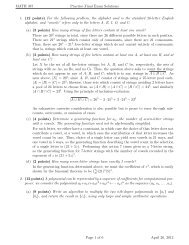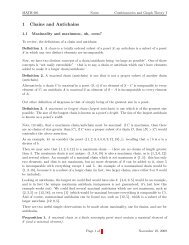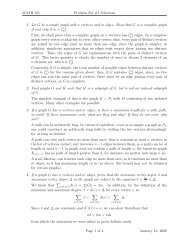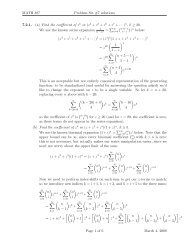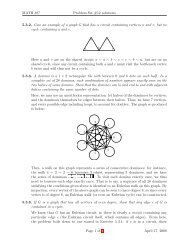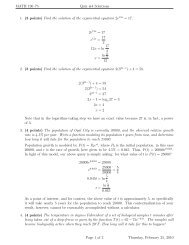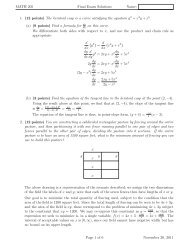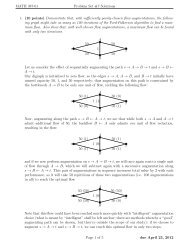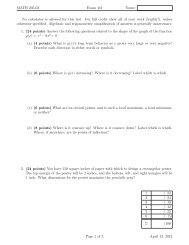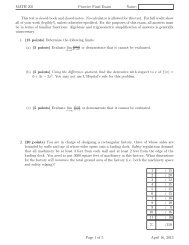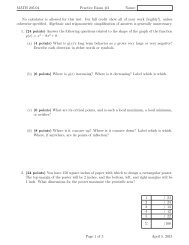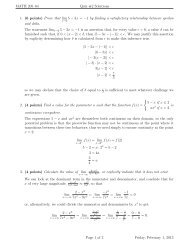Notes for 01/21
Notes for 01/21
Notes for 01/21
You also want an ePaper? Increase the reach of your titles
YUMPU automatically turns print PDFs into web optimized ePapers that Google loves.
MATH 682 <strong>Notes</strong> Combinatorics and Graph Theory II<br />
This is a pretty messy and long proof, but it is actually the standard proof, since it contains<br />
within it the seeds of a matching algorithm based on selecting an arbitrary matching, selecting an<br />
associated set S and seeing which of the above failures-of-maximality occur. There is, however,<br />
<strong>for</strong> fans of brevity, and <strong>for</strong> those who like clever conenctions among different branches of the same<br />
discipling, a very clever proof.<br />
The seed of this idea is that we have in fact proved a structurally similar result be<strong>for</strong>e! We have two<br />
structures, somewhat dual to eachother, one of which is consistently at least as large as the other.<br />
Our unusual result is that these structures are sometimes equivalent in size. If we replace “bipartite<br />
graph” with “poset”, “vertex cover” with “chain partition”, and “matching” with “antichain”, we<br />
have Dilworth’s Theorem!<br />
Alternative proof. For bipartite G = (A, B) with |G| = n, let us define the poset (V (G), ≼) by the<br />
relation a ≼ b iff a ∈ A, B ∈ B, and a ∼ b. Visually speaking, this is essentially rotating our graph<br />
90 degrees from a conventional bipartite representation and calling the result a Hasse diagram.<br />
By Dilworth’s Theorem, this poset has an antichain A and partition into chains C such that |A| =<br />
|C| = k <strong>for</strong> some k. This poset obviously has height of no more than 2, since every element of<br />
A is minimal and every element of B is maximal. Thus, the elements of C are of two types:<br />
single vertices in G (chains of size 1) and edges in G (chains of size 2). Let us denote C =<br />
{C 1 , . . . , C l , C l+1 , · · · , C k }, where C 1 , . . . , C l have size 2, and C l+1 , . . . , C k have size 1. Since these<br />
chains partition the poset, we know that ∑ k<br />
i=1 |C i| = |G|, which can be simplified to 2l+(k−l) = n<br />
or l = n − k. Since C is a partition of V (G), the chains are all vertex-disjoint, so in particular<br />
{C 1 , . . . , C l } is a vertex-disjoint collection of edges; that is to say, a matching of size n − k.<br />
Now we shall derive from A a vertex cover of size n − k to prove the König-Egerváry Theorem.<br />
Since A is an antichain, no two elements of A are comparable, which means by the construction<br />
of our poset that in G, there are no edges between elements of A (i.e., in graph parlance, A is<br />
an independent set). Thus, every single edge in G is incident on at most one member of A, and<br />
thus is incident on at least one member of V (G) − A. Thus V (G) − A is a vertex cover of G, and<br />
|V (G) − A| = n − k.<br />
Incidentally, it is also possible to prove Dilworth’s Theorem from König-Egerváry: <strong>for</strong> a poset<br />
(S, ≼), associate each s ∈ S with two vertices a s and b s of a bipartite graph G, and let a s ∼ b t iff<br />
s ≼ t. Then we reverse the process in the proof above: take the complement of a vertex cover to<br />
get an antichain, and kludge edges from a matching together to build a system of disjoint chains.<br />
This theorem tells us a lot about maximal matchings, but not when those matchings are perfect.<br />
However, it is a simple derivation from König-Egerváry to a perfection criterion:<br />
Theorem 2 (Hall ’35). For a bipartite graph G = (A, B), G has an A-perfect matching, if and<br />
only if <strong>for</strong> every S ⊆ A, |N(S)| ≥ |S|.<br />
Proof. The necessity of this condition was established in Proposition 1; here we shall show that the<br />
given condition is also sufficient.<br />
Let G be such that <strong>for</strong> all S ⊆ A, |N(S)| ≥ |S|. Clearly A is a vertex cover of G; we shall show that it<br />
is the smallest such. Suppose |S| < |A| and S is a vertex cover of A. Let S A = S∩A and S B = S∩B.<br />
Then, |S A |+|S B | = |S| < |A|. Let T = A−S A ; note that |T | = |A|−|S A | = |A|−(|S|−|S B |) > |S B |.<br />
By the condition given in the theorem, |N(T )| > |T |, so |N(T )| > |S B |. Thus, there is necessarily<br />
at least one vertex in T adjacent to a vertex not in S B . The edge between these vertices is clearly<br />
Page 4 of 7 January <strong>21</strong>, 2<strong>01</strong>0




